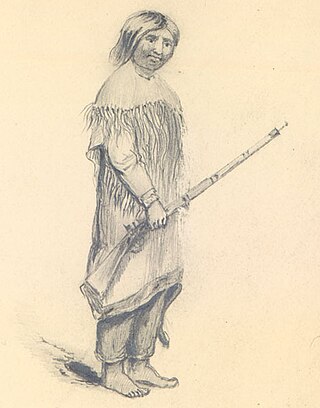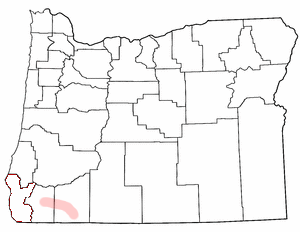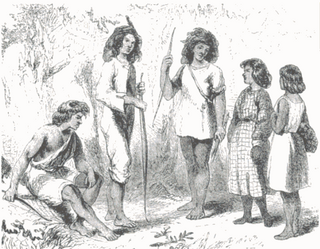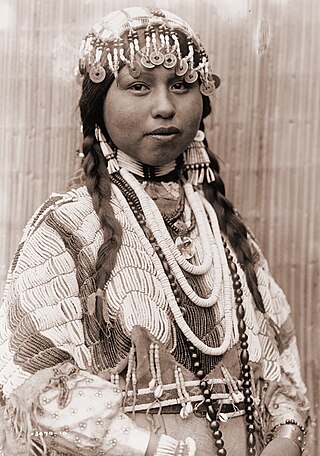
Lincoln County is one of the 36 counties in the U.S. state of Oregon. As of the 2020 census, its population was 50,395. The county seat is Newport. The county is named for Abraham Lincoln, 16th president of the United States.

Chinookan peoples include several groups of Indigenous people of the Pacific Northwest in the United States who speak the Chinookan languages. Since at least 4000 BCE Chinookan peoples have resided along the Lower and Middle Columbia River (Wimahl) from the river's gorge downstream (west) to the river's mouth, and along adjacent portions of the coasts, from Tillamook Head of present-day Oregon in the south, north to Willapa Bay in southwest Washington. In 1805 the Lewis and Clark Expedition encountered the Chinook Tribe on the lower Columbia.

The Siletz Reservation is a 5.852 sq mi (15.157 km²) Indian reservation in Lincoln County, Oregon, United States, owned by the Confederated Tribes of Siletz. The reservation is made up of numerous non-contiguous parcels of land in east-central Lincoln County, mostly east of the city of Siletz, between it and the Polk County line.
Coos people are an indigenous people of the Northwest Plateau, living in Oregon. They live on the southwest Oregon Pacific coast. Today, Coos people are enrolled in the following federally recognized tribes:

The Umpqua people are an umbrella group of several distinct tribal entities of Native Americans of the Umpqua Basin in present-day south central Oregon in the United States. The area south of Roseburg is now known as the Umpqua Valley.
The Siletz were the southernmost of several divisions of the Tillamook people speaking a distinct dialect; the other dialect-divisions were: Salmon River on the Salmon River, Nestucca on Little Nestucca River, Nestucca River and Nestucca Bay, Tillamook Bay on the Tillamook Bay and the mouths of the Kilchis, Wilson, Trask and Tillamook rivers, and Nehalem on Nehalem River. The name "Siletz" comes from the name of the Siletz River on which they live. The origin of the name is unknown

The Rogue River Wars were an armed conflict in 1855–1856 between the U.S. Army, local militias and volunteers, and the Native American tribes commonly grouped under the designation of Rogue River Indians, in the Rogue River Valley area of what today is southern Oregon. The conflict designation usually includes only the hostilities that took place during 1855–1856, but there had been numerous previous skirmishes, as early as the 1830s, between European American settlers and the Native Americans, over territory and resources.

Heceta Head Light is a lighthouse on the Oregon Coast 13 miles (21 km) north of Florence, and 13 miles (21 km) south of Yachats in the United States. It is located at Heceta Head Lighthouse State Scenic Viewpoint, a state park, midway up a 205-foot-tall (62 m) headland. Built in 1894, the 56-foot (17 m)-tall lighthouse shines a beam visible for 21 nautical miles, making it the strongest light on the Oregon Coast.
The Tolowa language is a member of the Pacific Coast subgroup of the Athabaskan language family. Together with three other closely related languages it forms a distinctive Oregon Athabaskan cluster within the subgroup.
The Confederated Tribes of Siletz Indians in the United States is a federally recognized confederation of more than 27 Native American tribes and bands who once inhabited an extensive homeland of more than 20 million acres from northern California to southwest Washington and between the summit of the Cascades and the Pacific Ocean. After the Rogue River Wars, these tribes were removed to the Coast Indian Reservation, now known as the Siletz Reservation. The tribes spoke at least 11 distinct languages, including Tillamook, Shasta, Lower Chinook, Kalapuya, Takelma, Alsea-Yaquina, Siuslaw/Lower Umpqua, Coos, the Plateau Penutian languages Molala and Klickitat, and several related Oregon Athabaskan languages.
The Coquille Indian Tribe is the federally recognized Native American tribe of the Coquille people who have traditionally lived on the southern Oregon Coast.
Coquelle Thompson was a Coquille Indian from the U.S. state of Oregon who was a cultural and linguistic consultant to at least six important anthropologists over the course of his long life. Born the son of a chief of the Upper Coquille Indians, and his Hanis Coos wife, he was among the several hundred Indians from southwestern Oregon who were removed by ship from Port Orford to the Coast or Siletz Indian Reservation in June 1856. His is an Indian eye-witness account of that removal. He grew up and lived on the Siletz Reservation, serving for decades as a member of the tribal police force.

The following is an alphabetical list of articles related to the U.S. state of Oregon.
The Tillamook are a Native American tribe from coastal Oregon of the Salish linguistic group. The name "Tillamook" is a Chinook language term meaning "people of [the village] Nekelim ", sometimes it is given as a Coast Salish term, meaning "Land of Many Waters". The Tillamook tribe consists of several divisions and dialects, including :
The Oregon Superintendent of Indian Affairs was an official position of the U.S. state of Oregon, and previously of the Oregon Territory, that existed from 1848–1873.

The Chetco are a tribe of Native Americans who originally lived along the lower Chetco River and Winchuck River in Curry County in the U.S. state of Oregon. The name Chetco comes from the word meaning "close to the mouth of the Chetco River" in their own language, which is part of the Athapascan languages. Although they were once one of the largest tribes on the Pacific coast of Oregon, "the last known full-blooded Chetco" living on the Chetco River died in 1940.

The Native American peoples of Oregon are the set of Indigenous peoples who have inhabited or who still inhabit the area delineated in today's state of Oregon in the Pacific Northwest region of the United States. While the state of Oregon currently maintains relations with nine federally recognized tribal groups, the state was previously home to a much larger number of autonomous tribal groups, which today either no longer exist or have been absorbed into these larger confederated entities. Six of the nine tribes gained federal recognition in the late 20th century, after undergoing the termination and restoration of their treaty rights starting in the 1950s.
The Western Oregon Indian Termination Act or Public Law 588, was passed in August 1954 as part of the United States Indian termination policy. It called for the termination of federal supervision over the trust and restricted property of numerous Native American bands and small tribes, all located west of the Cascade Mountains in Oregon. The act also called for disposition of federally owned property which had been bought for the administration of Indian affairs, and for termination of federal services which these Indians received under federal recognition. The stipulations in this act were similar to those of most termination acts.











